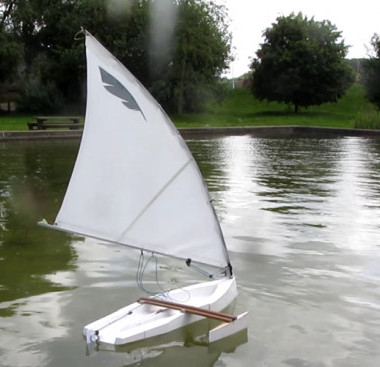Quill - a crab claw tacking proa
QUILL is an innovative tacking proa designed and built by Kim Fisher in England. The experimental vessel features a crab claw sail and a unique sliding outrigger arrangement. Kim writes:
Firstly, I would like to say a BIG thank you to Proafile for giving me mountains of useful information and encouragement to actually build this boat. I have been accessing your pages for over 3 years and this boat design is the result. (*blushing* -Editor) I am a committee member of the Amateur Yacht Research Society and at many meetings over the past ten years discussions have raged about Marchaj’s data on Crab Claw performance BUT nobody had built one to prove or disprove what he said. I just wanted to try one myself – hence I have built QUILL.
QUILL is a 15’ LOA x 4’ beam single-handed sailing dinghy with a crab claw shaped sail and a tacking proa layout. Total all up weight including rig is 107kg (236 lb.). It is GRP foam sandwich construction with carbon-fiber sliding seat, mast and boom. It has a pivoting centerboard and a “tubercle” shaped rudder blade. The cockpit is self draining.
The 10 sqm (108 sq. ft.) rig is different from other crab claws in that the yard is extended and becomes the mast similar to a cat boat. The unstayed mast is a lightly built OK dinghy mast with 50% less carbon fiber than standard to allow it much greater bend. The mast fits into a “dreadnought bow”. The boom is a standard windsurfer mast which has been bonded together and a sail track added. Both spars are built straight and bent by a powerful kicking strap to take up the flat sail’s curved edge shape. In true crab claw fashion the sail is cut absolutely flat. The only controls are kicker, outhaul, mainsheet and topping lift which is used to add fullness to the sail. To ensure the mast doesn’t snap at deck level an extra 2” diameter carbon tube was inserted into the first 1m of mast. The boat performs very well when close hauled, reaching and downwind. The tacking angle is approximately 65 degrees (Kim compares that with his other boat , a K1 keelboat: 88 degrees). Kim has also devised a system which allows the mast rake to be rapidly altered while sailing and can move the mast to vertical relative to the waterline. He has yet to do a set of comparative beating tests to see whether this improves the tacking angle.
Another design feature is the tacking ama assembly.
In the past I have sailed a boat with a sliding seat , a TOY sailing dinghy, and this frequently capsized to windward when I got it wrong! I therefore designed a seat with floats on the end to help prevent this.
QUILL has floats (amas) shaped to fit perfectly into cut-outs in the boat’s sides. When fully extended to one side the other ama is flush with the hull side - thus contributing little drag. The system has proved very stable and simple to operate. The ama to windward acts more like a stabilizing weight rather than a float as it gently flies most of the time - a true “flying” proa. The boat’s waterline is just below the chine line so the dent in the side does not actually cut the water very often - the boat sails at low angles of heel.
Congratulations to Mr. Fisher for a successful proa experiment. The tacking, sliding outrigger proa may provide the best of both worlds: the benefits of a flying proa along with the proven efficiencies of one-way hulls, sails and boards.
Editor’s note: A similar sliding outrigger was used in the 1978 world sailing speed record contender SLINGSHOT. According to archival photos, the leeward ama tucked up against the hull did indeed cause considerable spray.
——-
——-
Read more about the crab claw rig: Proa Rig Options: Crab Claw







Well done Kim for getting out there, getting sticky, getting wet and trying to get some real data.
Could there be a typo on the tacking angle numbers by any chance. 65 Deg seems….rather too good?
Is he going to try another (bermudan) rig as a baseline to compare against?
I hope he write an AYRS paper to collect his findings and prove Marchaj right or wrong.